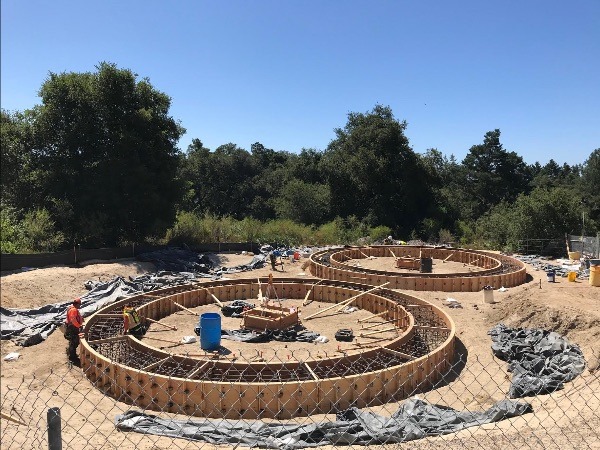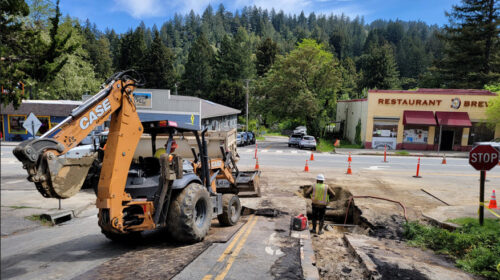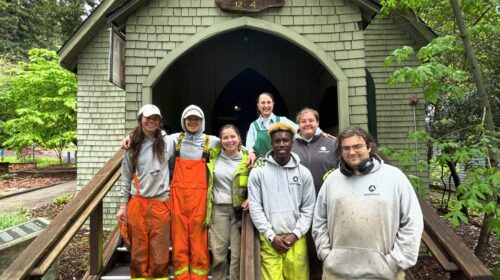Long Term Engagement or Shotgun Wedding? SLV and Scotts Valley Water Districts Explore a Merger
By Jayme Ackemann
Last month, as the San Lorenzo Valley was beginning to worry about debris flows and a lack of precipitation, the SLV and Scotts Valley water districts threw out a pretty significant trial balloon: A merger proposal.
At the District’s February 4th board meeting, directors and staff hashed out a loose framework to study a merger. So loose, the merger proposal feels more like a shotgun wedding after a quick courtship.
The consolidation process is involved. If the San Lorenzo Valley Water District hopes this will be a path towards post-fire financial recovery, it won’t be in the near term. LAFCO, the Santa Cruz Local Agency Formation Commission laid out a merger path that, “begins with an exploratory phase of at least one year that includes an analysis of both districts and input from a stakeholder group that includes representatives from both districts.”
But the history of similar Water District mergers suggests even that one year timeline may be optimistic. A May 2018 study issued by Berkeley’s Center for Law, Energy & the Environment, “Learning from California’s Experience with Small Water System Consolidations,” acknowledges that small water systems bear a significant burden in keeping up with the costs of safe water provision and that mergers can provide economies of scale. But at what cost?
In the San Joaquin Valley, one such merger between the Byron-Bethany Irrigation District and the West Side Irrigation District took four years to cross the finish line in October 2020, after first beginning the “one-year exploratory phase” in 2016.
Two Valleys, Different Approaches
Meanwhile both agencies have customer concerns to contend with following some pointed questions raised as part of the proposal’s February rollout. For San Lorenzo Valley customers the differences between the two valley communities raise a possible source of conflict.
“These two communities are very different,” said San Lorenzo Valley resident and former Santa Cruz County Supervisor Joe Cucchiara. “This is the dumbest idea since the pet rock.”
His concern, echoed by other SLV residents, reflected the differences in growth priorities between the two communities. San Lorenzo Valley has more existing connections but a zero-growth development policy that makes future proposed demand for local water fairly static.
Scotts Valley Water District Manager Piret Harmon indicates that Scotts Valley’s projected water needs only reflect an anticipated growth of .3% per year – a tiny fraction more than San Lorenzo Valley’s projected .2% annual water demand increases – but some SLV residents view Scotts Valley as likely to continue to be pro-development in the future placing increased demands on a merged water system. But Scotts Valley residents raise concerns of their own around the recovery costs related to last summer’s CZU Lightning Complex Fire.
Engaging the Community
Berkeley’s Small Water System Report indicates that mergers are likely to be the only path forward for agencies overburdened by infrastructure investment costs and regulatory requirements. Without the economic relief that shared costs offer, ratepayers are asked to shoulder those burdens.
SLV Water District is facing urgent challenges. The “right time” to begin exploring sweeping change is always difficult to find and the questions around structure and cost that could result from any merger can’t be answered without initiating a merger exploration, according to guidelines provided by LAFCO.
But the Water District has long been criticized for poor community outreach, including as recently as the Santa Cruz County Grand Jury’s May 2018 report, which said the following:
“Better communication on difficult matters, an informed and effective Assessment District oversight committee, and an unwavering commitment to public access, will enable greater transparency and may restore trust and foster better relationships within the SLVWD community.”
More than 100 community members made time to attend a virtual meeting on short notice, following SLVWD’s Feb. 2 announcement that it would seek permission to begin exploring a merger with the Scotts Valley Water District. Since clearly there is an audience interested in engaging on this issue, one assumes that with greater public outreach more SLV residents will be interested in this discussion.
SLV residents should have an opportunity to set the terms upon which a merger could be successful rather than just providing feedback on a fully baked proposal.
SLV lacks direct representation and the voice and leverage local representation offers when engaging with regional, state, and even federal agencies. Without local town or city council representation, the valley doesn’t have the same voice that its counterpart in Scotts Valley enjoys. Both communities share a County Supervisor, but for SLV that is where the direct local representation ends. Scotts Valley residents also have their city council members with whom they can exchange feedback and work to solve problems.
Ensuring this process includes SLV concerns will require the water district to go well beyond its previously criticized public outreach efforts such that any exploratory process feels authentic and representative of the Valley’s feedback. If the process moves forward, the Water Districts should jointly engage a clear plan for gathering local feedback and creating an equitable exploration of the issue for both communities.
Scotts Valley, in addition to having more direct representation as an incorporated city, is also a wealthier community. Rate and representative equity are considerations both communities will need to address.
The shotgun wedding announcement was followed by a promise that the District would slow the courtship down. Whether San Lorenzo Valley residents will get to chaperone that courtship remains to be seen.
Jayme Ackemann is a public affairs consultant and freelance writer. Ackemann has worked on major capital investments and water infrastructure capital construction projects in the Bay Area. Jayme has been a resident of Ben Lomond for more than 15 years.
Feature photo: Replacement redwood tank construction, Lompico July 2020. Photo from SLVWD.com.





.3% vs. .2% growth?
I find this projection really hard to believe considering all the development Scotts Valley is currently experiencing as well as its obvious future potential for growt.:
“Scotts Valley Water District Manager Piret Harmon indicates that Scotts Valley’s projected water needs only reflect an anticipated growth of .3% per year – a tiny fraction more than San Lorenzo Valley’s projected .2% annual water demand increases”
Right. We could not find any other source to back up Piret’s comment. Still looking.